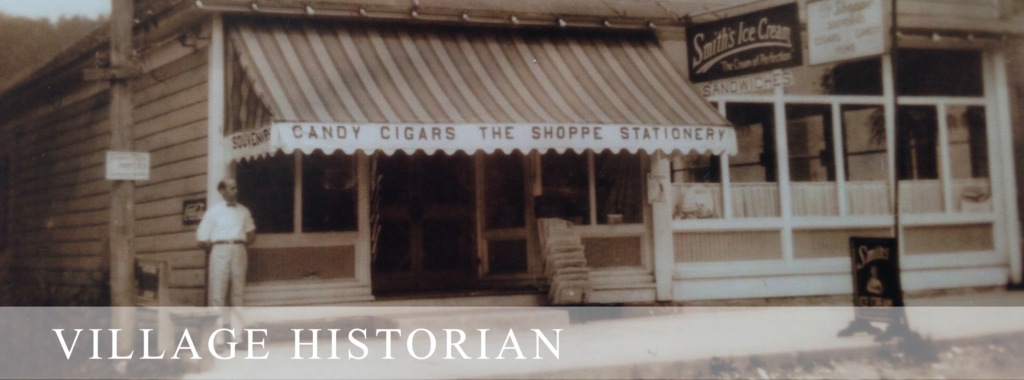
William Cutler – 845-482-4275
The Town of Callicoon was created in 1870. The name Callicoon came from a Dutch word, Kollikoonkill, which translated into “cackling hen” after the many wild turkeys native to the area. The land was largely owned by non-residents who were not willing to foot the bill to have roads built through their property. This was one of the last territories to be settled in the county. When the New York & Erie Railroad came into the area, access to this beautiful wild area opened up. People began to settle and towns were born. One of these settlements in the Town of Callicoon was Jeffersonville.
Although the earliest recorded settlers of Jeffersonville were Jacob and Cornelius Knockerbockers Schermerhorn, Thomas S. Ward built the town’s first frame house in 1839. Ward, a very large man, made money by settling disputes between people in the area. He eventually applied for and received a license to practice law. In 1842, about 110 Swiss immigrants settled in the area surrounding where the Presbyterian Church on Main Street now stands. The Swiss named the little settlement the Winkelried Society after the Swiss patriot, Arnold Von Winkelried.
Another early settler came for health reasons. He was Charles F. Langhorn, who had a heart condition, was advised by his doctor to settle in an area that was abundant with hemlock. It was believed that the hemlock tree had medicinal benefits. He settled in Jeffersonville in 1846 and built the first hotel. He was an avid admirer of the Declaration of Independence, so he named his hotel the Jefferson House. It is believed that this is how Jeffersonville got its name. The Mansion House was another hotel in Jeffersonville. Olney A. Borden, the first Town of Callicoon Supervisor, owned it. The first commercial hotel to open its doors in the summer to city guests was The Beck in 1882. It had 45 rooms. The Beck supplied a stagecoach to meet the O & W train daily. By 1912, The Beck had accommodations for 150-200 guests. In December 1912, Mr. Beck put an oil lamp on the 2nd floor to keep the pipes warm. Unfortunately, this lamp caused a fire, which destroyed the hotel.
To read full article, please visit http://jeffersonvilleny.com/our-history/
SYNOPSIS OF JEFFERSONVILLE
• Original settlers in the 1830¹s were Dewitt, Quick, Schermerhorn, Ward, Hofer, Scheidell, Schneider.
• First commercial hotel: The Beck House, 1882, was located on the “island”; no longer standing, it burned down.
• Telegraph: linked Jeffersonville to Liberty, 1887.
• Village Board meetings held at: Lieb¹s office, the Mansion House, the Dolly Madison Shoppe, Ed Weber¹s office, Segar¹s store, upstairs at the firehouse, settling finally at the “Old Firehouse,” which presently is the Village Hall on Center Street. Russell Duttweiler donated this building to the village.
• First village election: November 11, 1924. President: William Lieb, Trustees: Howard C. VanKeuren and Abram Friedman, Supt. of Public Works: William H. Lawrence, Temporary Clerk: Charles Hick, Replaced by: Robert Mann, Treasurer: Otto Bollenbach
• Population: In 1950 = 421. In 1990 = 484.
• Eagle Hotel fire in 1918, destroyed many businesses. The hotel fronted from the current Ted¹s Restaurant through the hardware store along Main Street, and the property extended back to Jefferson Avenue.
• First bus route was to Liberty in 1911, a 12-passenger car run by Fred Duttweiler.
• April, 1939: Officially adopted Daylight Savings Time.
• Persons in the same house now as they were in 1985: 237 persons.
• Average travel time to work in 1998: 24 minutes.
• Longest term in Mayor¹s office: Frederick W.V. Schadt, 42 years. Also, longest term in USA.
• Longest term as Trustee: Russell E. Duttweiler, 32 years.
• Longest term as Clerk/Treasurer: Louise Gorr, 26 years.
• Longest term as Health Officer: Dr. J.C. Gain, 25 years.
• Longest term as Justice: Walter McKeen, 19 years.
• Historians: Martha M. Scheidell, 5 years; Joseph (Jesse) Abel, 11 years; Maureen Schlott, present.